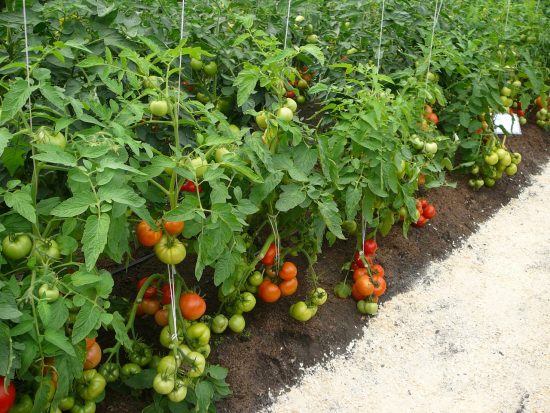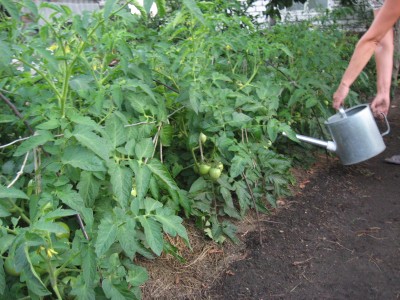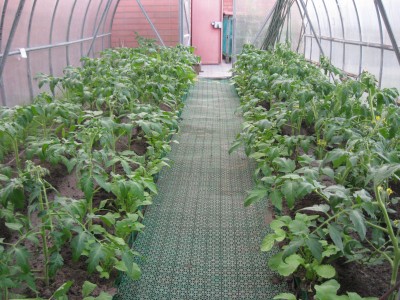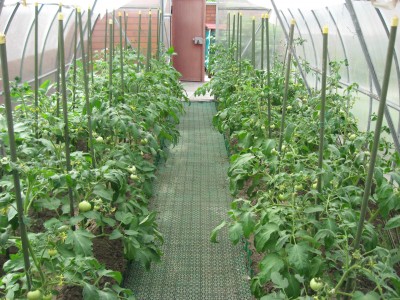All plants have different requirements for individual nutrients. If cucumbers require a lot of nitrogen for good development, then when growing tomatoes you should not get carried away with nitrogen fertilizing.
Unfortunately, many summer residents recognize only urea among all fertilizers. You can understand them: after fertilizing with nitrogen, tomatoes grow quickly - the bushes become juicy and luxurious. But the external splendor of the leaves and stems hides their vulnerability to pests and diseases.
Plants overfed with nitrogen are the first to succumb to the pressure of viruses; they produce a lot of leaves and few fruits.
It is better to feed plants nothing at all than to feed them incorrectly.
How to feed tomatoes in open ground
Tomatoes extract many nutrients from the soil. Most of all they need potassium, a little less nitrogen. Tomatoes consume several times less phosphorus than potassium, but it plays an exceptional role in fruit formation. It is very important that plants receive phosphorus already during the seedling period (a teaspoon of superphosphate per kg of soil mixture). Seven times less nitrogen and potassium fertilizers are added to this volume of soil. In this situation, the seedlings bloom and begin to bear fruit earlier.
Tomatoes especially need potassium during the period of fruit formation and ripening. During the growing season, mineral fertilizers for tomatoes are best applied in dissolved form.
Tomatoes are responsive to organic fertilizers: 4-6 kg of humus per square meter. m for digging. At the same time, the bulk of the mineral fertilizers necessary for the development of tomatoes is added: Art. spoon of superphosphate and 2 tbsp. spoons of potassium sulfate per sq. m. Humus and compost can be added to each hole when planting. On light soils, manure is also used, but only for autumn digging (4-5 kg per sq. m). Manure, like nitrogen fertilizers, promotes strong development of vegetative mass to the detriment of fruiting.
The first vegetative feeding carried out during the period of budding and the beginning of flowering: per 10 liters. add 0.5 liters of organic infusion (chicken manure, mullein, green grass) and superphosphate extract prepared from tbsp. spoons of fertilizer.
Second feeding - during the flowering period of the second cluster: by 10 l. water 0.5 l.organic infusion and a tablespoon of complex mineral fertilizer.
Third feeding — during the flowering period of the third cluster: a tablespoon of complex fertilizer per 10 liters. water.
It is useful to alternate root feeding with foliar feeding, but the concentration of the solution should be 2 times less. Before fruiting You can spray the tomatoes with a urea solution. To prepare the solution, dissolve half a tablespoon of urea and 1 gram in a bucket of water. potassium permanganate.
After fruiting It is better to spray the plants with potassium sulfate, potassium magnesia, potassium nitrate in the same concentration (half a tablespoon of fertilizer per 10 liters of water). You can also use complex soluble min. fertilizers
It is advisable to spray tomatoes in the evening or early in the morning so that the moisture does not dry out on the leaves longer.
This video clearly shows how and what to feed tomatoes in open ground.
How to feed tomatoes in a greenhouse
To get a high yield in a greenhouse, you need to take care of the soil: it must be light and fertile. The top layer of soil in a greenhouse can consist of a mixture of turf soil, humus, sand (1: 2: 0.5), for each square meter add a tablespoon of superphosphate, potassium sulfate, if the soil is prepared in the fall. In the spring, the same amount of urea is added.
They begin to prepare the soil in the greenhouse in the fall so that pests freeze out in it over the winter.
One day before and one day after planting, the seedlings are treated with Epin-extra (solution concentration according to instructions) so that they take root faster and more painlessly and increase resistance to adverse conditions and diseases. A week after planting, the tomato seedlings need to be fed by leaves. This helps plants strengthen their root system and quickly gain vegetative mass.Vegetable growers who grow tomatoes in a greenhouse note the effectiveness of the water-soluble fertilizer Plantafol.
For the first and second foliar feedings, take plantafol with a high phosphorus content (plantafol 10:54:10). Third foliar feeding (stimulates flowering): plants are sprayed with plantafol, which contains equal amounts of nitrogen, phosphorus, potassium (20:20:20). During the period of the beginning of flowering and fruit formation, they work with plantafol with a high potassium content (plantafol 5:15:45). For 10 liters of water, consume 20 g of plantafol (about a tablespoon).
At least three times during the growing season we feed tomatoes at the root.
First feeding - during the budding period: 0.5 liters of infusion of bird droppings or mullein and a superphosphate extract prepared from 1-1.5 tablespoons of fertilizer, per 10 liters of water (the superphosphate extract is prepared as follows: the superphosphate must be crushed and poured with hot water for a day) . You can select modern complex fertilizers for tomatoes, which are produced taking into account the crop’s nutritional needs by development phase.
Second feeding — during the period of active flowering of the second cluster: a tablespoon of complex fertilizer per 10 liters of water.
Third feeding — at the beginning of the third cluster blooming: a tablespoon of complex fertilizer per 10 liters of water. When feeding for the first time, a liter of nutrient solution is enough for one plant. More mature plants should receive 1.5-2 liters.
But don’t overdo it: it’s better to underfeed than to overfeed.
If, after all, the tomatoes in the greenhouse have become fattened (powerful bushes do not bear fruit well), they should be reoriented to fruiting: make an extract of superphosphate at the rate of 3 tbsp.spoons per 10 liters of water and pour over the tomatoes (liter of solution per plant).
Once every two weeks, to prevent blossom end rot, foliar feeding is carried out with a solution of calcium nitrate and plantofol (a tablespoon per bucket of water).
Watch a video from Oktyabrina Ganichkina on how to feed tomatoes in a greenhouse:
Feeding tomatoes with folk remedies
Summer residents have always used folk remedies to feed tomatoes, many of which are no less effective than mineral fertilizers. Over time, the range of such products has become even wider. We will now talk about the most popular of them.
How to prepare mullein feed
Mullein is perhaps the most proven and effective way to fertilize plants. However, the “raw materials” for this fertilizer are becoming more and more expensive and scarce every year. If you still have the opportunity to get it, then by all means take advantage of it.
Fill a bucket of fresh cow dung with three buckets of water and let it ferment for 7 - 10 days. After this, add one liter of mullein to a bucket of water and water the tomatoes 1 - 1.5 liters per bush. No more than two such feedings can be done, otherwise the plants may become fatty.
Chicken manure supplement It is prepared in the same way, only add not a liter, but 0.5 liters of infusion to a bucket of water. It is recommended to water the tomatoes before fertilizing. The very next day the plants will respond to this fertilizer.
We feed tomatoes without chemicals:
Yeast fertilizer for tomatoes
Recently, it has become very fashionable to feed tomatoes with yeast. Regular baker's yeast, both fresh and dry, is suitable for this.
The recipe is simple: 100 gr.dilute fresh yeast in a bucket of water and the fertilizing is ready, you can water it immediately.
Dry yeast (10 g packet) is also diluted in 10 liters. water and leave for 2 - 3 hours. You can add 2 - 3 tablespoons of sugar to a bucket of such a solution.
You just need to keep in mind that yeast contains no nitrogen, no phosphorus and no other trace elements. So it is more likely not a feeding, but a growth stimulator.
I myself have used yeast fertilizer several times when growing tomatoes, cucumbers, and peppers. Unfortunately, I didn’t notice any particular effect, but there won’t be any harm to the plants either. If you have time and desire, you can experiment, maybe you will have better luck.
But tomatoes immediately respond with gratitude to fertilization with mullein, ash or herbal infusion.
The author of this video fed some of the tomato seedlings with yeast, but some did not. You can find out what he did by watching the video:
How to feed tomatoes with ash
Folk remedies for feeding tomatoes also include ash, which is a real complex fertilizer. It contains a huge amount of various microelements. It contains a lot of potassium, calcium, magnesium, sodium, and these are exactly the nutrients that all garden plants, including tomatoes, need.
Dry ash is added to the holes when planting seedlings, and sprinkled on the beds with tomatoes. But it is better to fertilize tomatoes with an ash solution.
The recipe is very simple: Stir a glass of ash in a bucket of water and get an ash solution of the desired concentration. An insoluble sediment always remains at the bottom of the bucket; this is also poured into the garden bed.
Ash solution for foliar feeding They prepare it a little differently: 300 gr. The ashes are stirred in three liters of water and boiled for 30 minutes.Let it brew for 5 - 6 hours, bring the volume to 10 liters and add a little laundry soap. The resulting solution is filtered and spraying begins.
Unfortunately, finding ash now is not so easy for many summer residents. But there is always an abundance of weeds in every area, and you can make excellent fertilizer from ordinary grass.
Feed your tomatoes with nettle infusion
Most often, it is recommended to prepare a herbal infusion from young nettles. The fact is that a lot of nitrogen, potassium, and iron accumulate in nettle leaves. But it is not at all necessary to look for nettles; any herb will do. The more diverse the range of weeds, the better. After all, alfalfa, for example, is rich in phosphorus, dandelion in calcium, etc.
To prepare the infusion, you will need some kind of container (preferably plastic), a large saucepan, a barrel. You can even put cellophane film into a holey barrel and prepare a solution in it.
Fill the container 2/3 with grass and fill it with water, but not to the top (because the solution will ferment). Cover with a lid and leave for 10 days. When fermentation is over, you can feed the tomatoes and all other plants with the infusion.
To prepare the fertilizer, dilute 1 liter of infusion in a bucket of water and pour 1.5 - 2 liters of tomatoes per bush. This fertilizer seems quite harmless, but you should not abuse it; two fertilizings per month are enough.
Particularly careful gardeners add manure, wood ash, superphosphate extract and much more to herbal tea. This further enriches the prepared solution, but then it should be used even more carefully.An excess of nutrients in the soil will lead to the accumulation of nitrates in vegetables.
Remember - it’s better not to overfeed!
Video about feeding tomatoes with nettle infusion:
What does feeding tomatoes with iodine give?
Many gardeners are interested in the question: why feed tomatoes with iodine? What does this give?
They do this so that the tomatoes ripen faster. Iodine helps to increase the number of ovaries and the rapid growth of tomatoes. Experts say that the taste of tomatoes becomes better.
To prepare this fertilizer, add 3 ml to a bucket of warm water. iodine and water the tomatoes 0.5 liters per bush. To measure 3 ml. iodine, use a medical syringe. Use a syringe to extract 3 ml from the vial. and squirt it into a bucket of water. Be sure to mix everything well.
Why are tomatoes fed with whey?
This is more likely not a feeding, but a prevention of late blight. The product is strong, effective and at the same time cheap and not harmful.
It is prepared like this: buy 1 liter of whey in the store, mix it with 9 liters of water, add 20 - 30 drops of iodine and stir well so that the iodine disperses in the water. Tomatoes should be sprayed in the evening in calm weather.
It is recommended to alternate such sprayings. Once with serum with iodine, and after 2 weeks with Fitosporin, then again with serum. However, we do without Fitosporin. We feed our tomatoes only with serum with iodine after 10 - 15 days and late blight never occurs, and the plants themselves look refreshed after such treatments.
A very good product not only for tomatoes, but also for cucumbers!
We will be glad if you share your experience and tell us how you feed tomatoes, this can be done in the comments.
Continuation of the topic:
- How to properly water and feed tomato seedlings
- Tomato diseases, their treatment and prevention
- What to do if tomato leaves curl
- How to properly pick tomatoes
- How to protect tomatoes from late blight
- Caring for tomatoes in a greenhouse from planting seedlings to harvesting
- Growing tomatoes in open ground from A to Z





 (24 ratings, average: 4,79 out of 5)
(24 ratings, average: 4,79 out of 5) CUCUMBERS NEVER GET SICK, I'VE BEEN USING ONLY THIS FOR 40 YEARS! I SHARE A SECRET WITH YOU, CUCUMBERS ARE LIKE THE PICTURE!
CUCUMBERS NEVER GET SICK, I'VE BEEN USING ONLY THIS FOR 40 YEARS! I SHARE A SECRET WITH YOU, CUCUMBERS ARE LIKE THE PICTURE! You can dig a bucket of potatoes from each bush. Do you think these are fairy tales? Watch the video
You can dig a bucket of potatoes from each bush. Do you think these are fairy tales? Watch the video
 How our fellow gardeners work in Korea. There is a lot to learn and just fun to watch.
How our fellow gardeners work in Korea. There is a lot to learn and just fun to watch. Eye trainer. The author claims that with daily viewing, vision is restored. They don't charge money for views.
Eye trainer. The author claims that with daily viewing, vision is restored. They don't charge money for views. A 3-ingredient cake recipe in 30 minutes is better than Napoleon. Simple and very tasty.
A 3-ingredient cake recipe in 30 minutes is better than Napoleon. Simple and very tasty. Therapeutic exercises for cervical osteochondrosis. A complete set of exercises.
Therapeutic exercises for cervical osteochondrosis. A complete set of exercises. Which indoor plants match your zodiac sign?
Which indoor plants match your zodiac sign? What about them? Excursion to German dachas.
What about them? Excursion to German dachas.
Thank you very much for such a great article! A lot of useful information, all in one article.
I’m very glad, Svetlana, that you liked the article. Come visit us more often, you might find something else interesting for yourself.
Thanks a lot! For the article, for new knowledge! How many new things I learned!!! And in order not to forget all the subtleties (what, how and how much, and most importantly for what) - you need to keep a diary of an amateur gardener!!! I will definitely do this! I have another question - is it possible to feed tomatoes and cucumbers with the remaining bread - white and black, with mold?
Larisa, you can feed them with moldy bread, but I’m afraid it won’t do much good.
Good article. Just correct errors in the text before posting the article on the site.
I don't agree about the yeast. Look at the chemical composition of yeast. Yeast contains nitrogen, phosphorus and potassium. The point here is different: for yeast to have the same effect as manure or humus, it must be added in the same quantities.After all, if you take 100 g of manure and dilute it in 10 liters of water, then the effect of this “feeding” will be comparable to a yeast “extract”. It’s just a matter of quantity, and in the quantities in which the yeast extract is prepared, it really works as a stimulant due to biologically active substances.